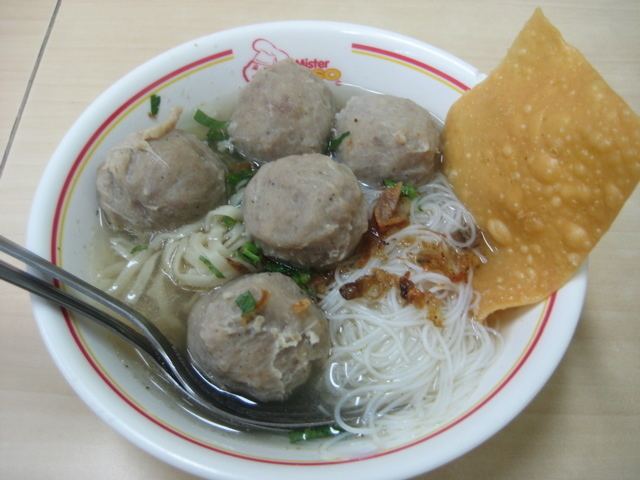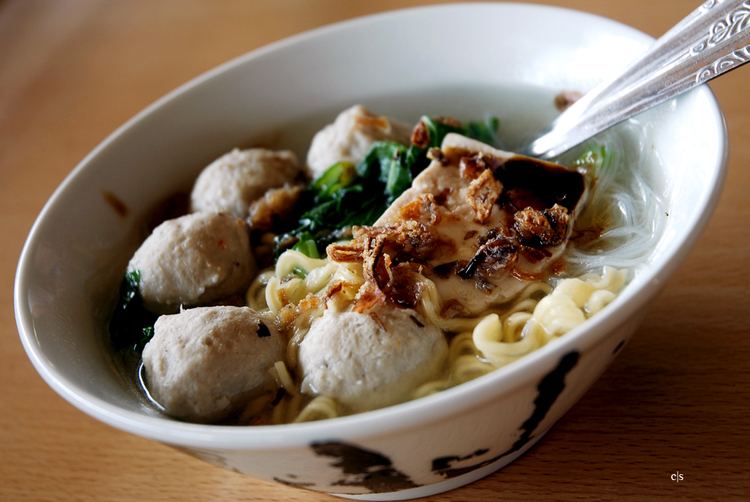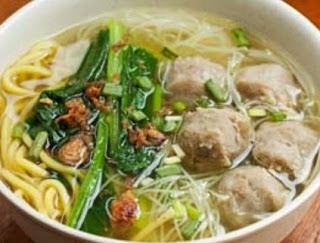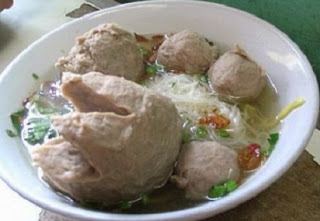Course Main Serving temperature Hot | ||
 | ||
Region or state Nationwide in Indonesia, also popular in neighboring Southeast Asian countries Main ingredients Ground beef, tapioca, noodle, rice vermicelli, beef broth, kailan, celery, salted vegetables, fried shallots Similar | ||
How to make meatballs recipe bakso indonesian version eps 5 hijabchef
Bakso or baso is Indonesian meatball, or meat paste made from beef surimi. Its texture is similar to the Chinese beef ball, fish ball, or pork ball. The term bakso could refer to a single meatball or the whole bowl of meatballs soup.
Contents
- How to make meatballs recipe bakso indonesian version eps 5 hijabchef
- Ingredients contents and serving
- Origin
- Variations
- Popularity
- Similar dishes
- Health issue
- References

Bakso can be found all across Indonesia; from the traveling cart street vendors to restaurants. Next to soto, satay and siomay, bakso is one of the popular street food in Indonesia. Today, various types of ready to cook bakso also available as frozen food commonly sold in supermarkets in Indonesia.

Ingredients, contents and serving

Bakso is commonly made from finely ground beef with a small quantity of tapioca flour and salt, however bakso can also be made from other ingredients, such as chicken, pork, fish or shrimp. Unlike other meatball recipes, bakso has a consistent firm, dense, homogeneous texture due to the polymerization of myosin in the beef surimi.
As most Indonesians are Muslims which observes halal dietary law, generally bakso is made from beef, chicken or the mixture of beef with chicken. While in non-Muslim majority areas, such as in Chinatowns in major cities and Hindu majority island of Bali, pork bakso might be found.

Traditionally the beef surimi paste or dough is made into balls using hands and boiled in hot water right away. After the meat are done, the meatballs are floating on boiling water, collected and being dried, stored or refrigerated for further use. Bunch of pre-cooked bakso are usually displayed in the window of a street vendor cart, and will be boiled in hot water per customer order, prior of serving.

Bakso are usually served in a bowl of beef broth, with yellow noodles, bihun (rice vermicelli), salted vegetables, tofu, egg (wrapped within bakso), Chinese green cabbage, bean sprout, siomay or steamed meat dumpling, and crisp wonton, sprinkled with fried shallots and celery. Slices of bakso often used and mixed as compliments in mi goreng, nasi goreng, or cap cai recipes.
Origin
The name bakso originated from bak-so (肉酥, Pe̍h-ōe-jī: bah-so·), the Hokkien pronunciation for "fluffy meat" or "minced meat". This suggests that bakso has Indonesian Chinese cuisine origin. Chinese influences is apparent in Indonesian food, such as bakmi, mie ayam, pangsit, mie goreng, kwetiau goreng, bakso and lumpia. Indeed, bakso texture is quite similar to Chinese beef balls, which is quite fluffy and has homogenous texture. Although bakso has Chinese Hokkien origin name, culinary experts suggests that it is likely that bakso was the mixture of culinary influences back in colonial Dutch East Indies. Also in Indonesian, the term bola daging is often refer to Western or European style of meatballs, which is different in texture and elasticity compared to bakso. For example, the Swedish meatballs is translated as bola daging Swedia in Indonesian. The soup and the noodles probably originated in China, but the meatball, may have come from the Dutch, who colonized Indonesia in the 19th century.
Despite its possible Chinese origin, bakso seems to had undergone localization, especially into Chinese Indonesian and Javanese cuisine. Today, most of the bakso vendors are native Javanese from Wonogiri (a town near Solo) and Malang. Bakso Solo and Bakso Malang are the most popular variant; the name comes from the city it comes from, Solo in Central Java and Malang in East Java. Bakso Solo is usually served with yellow noodle and rice vermicelli in beef broth, while Bakso Malang usually is enrichen with tofu and crispy fried wonton. In Malang, bakso bakar (roasted bakso) is also popular.
Variations
Indonesia has developed numbers bakso variants, usually differs by its shape and size, texture, ingredients or fillings.
Popularity
Bakso is one of the most popular street food in Indonesian cities and villages alike. Travelling street vendors, either by carts or bikes are often frequenting residential areas in Indonesia, while bakso warung and humble tent foodstalls are often sprung on street sides in Indonesian cities. Bakso first came to international attention when the United States President Barack Obama remember it as one of his favourite food from his childhood in Indonesia, and mentioned it in his speech.
Similar dishes
Similar meatball dishes can be found in other Southeast Asian cuisines, such as those in Thailand, Vietnam, Malaysia and Singapore, as well as Chinese-style meatballs.
The dish also similar with Vietnamese noodle soup with meatballs, Phở Bò Viên. In Vietnam, Phở means noodle soup while Bò Viên is meatballs. Phở Bò Viên is one of version of Pho dish in Vietnam. It has been considered as the national dish of Vietnam.
In Malaysia and Singapore, there is a similar meatball soup called bebola daging, which actually a Malay translation of "meatball". Many recipe of bebola daging in Malaysia and Singapore are actually derived from either Western (Indian or European) and Eastern (Chinese) meatballs, such as bebola daging Masala which is derived from Indian cuisine influence.
In the Philippines, meatballs are called almondigas or bola-bola, and are usually served in a misua noodle soup with toasted garlic, squash and pork cracklings. Bola-bolas are also stewed or pan-fried until golden brown.
Health issue
In Indonesia, borax is often added into beef surimi mixture in order to preserve the produced bakso, also to make bakso more chewy (from borax induced myosin cross-linking) with less usage of meat. As a result, bakso is often listed by Indonesian Food and Drug Administration as an unhealthy foodstuff. The country's Directorate of Consumer Protection warns of the risk of liver cancer caused by high consumption over a period of 5–10 years. Therefore, frozen bakso being sold at supermarkets and also traditional markets in Indonesia are required to be borax free.
